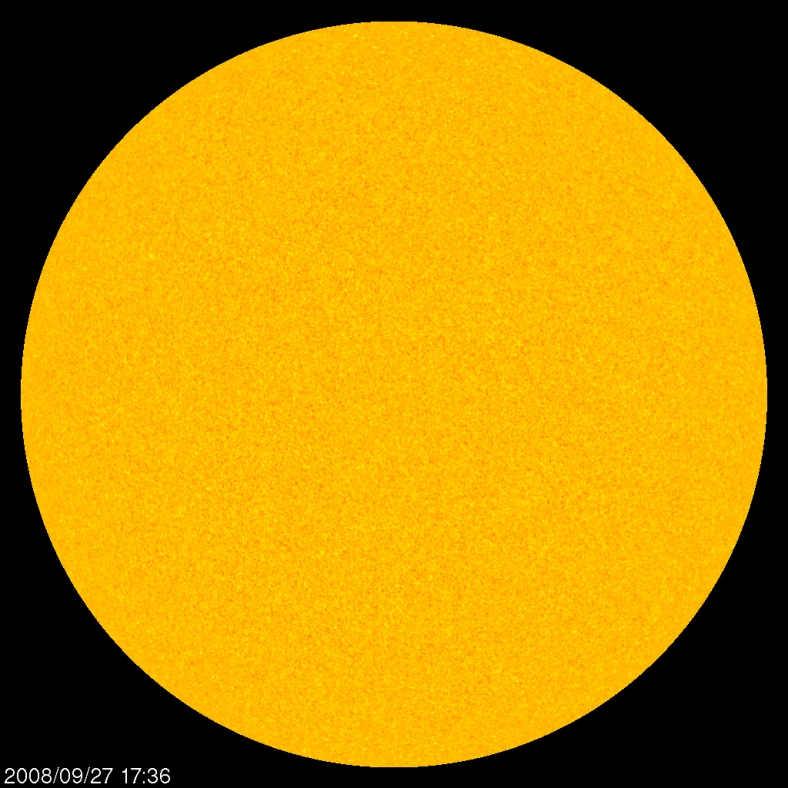
|
||||||||||||
|
|
|
Researchers Crack the Mystery of the Spotless Sun
03.02.11
Now they know. An answer is being published in the March 3rd edition of Nature. Plasma currents deep inside the sun interfered with the formation of sunspots and prolonged solar minimum," says lead author Dibyendu Nandi of the Indian Institute of Science Education and Research in Kolkata. "Our conclusions are based on a new computer model of the sun's interior." For years, solar physicists have recognized the importance of the sun's "Great Conveyor Belt." A vast system of plasma currents called ‘meridional flows’ (akin to ocean currents on Earth) travel along the sun's surface, plunge inward around the poles, and pop up again near the sun's equator. These looping currents play a key role in the 11-year solar cycle. When sunspots begin to decay, surface currents sweep up their magnetic remains and pull them down inside the star; 300,000 km below the surface, the sun’s magnetic dynamo amplifies the decaying magnetic fields. Re-animated sunspots become buoyant and bob up to the surface like a cork in water—voila! A new solar cycle is born. For the first time, Nandi’s team believes they have developed a computer model that gets the physics right for all three aspects of this process--the magnetic dynamo, the conveyor belt, and the buoyant evolution of sunspot magnetic fields. "According to our model, the trouble with sunspots actually began in back in the late 1990s during the upswing of Solar Cycle 23," says co-author Andrés Muñoz-Jaramillo of the Harvard-Smithsonian Center for Astrophysics. "At that time, the conveyor belt sped up." The fast-moving belt rapidly dragged sunspot corpses down to sun's inner dynamo for amplification. At first glance, this might seem to boost sunspot production, but no. When the remains of old sunspots reached the dynamo, they rode the belt through the amplification zone too hastily for full re-animation. Sunspot production was stunted.
Three years ago on March 2, 2008, the face of the sun was featureless--no sunspots. Credit: SOHO/MDI
One thing is clear: During long minima, strange things happen. In 2008-2009, the sun’s global magnetic field weakened and the solar wind subsided. Cosmic rays normally held at bay by the sun’s windy magnetism surged into the inner solar system. During the deepest solar minimum in a century, ironically, space became a more dangerous place to travel. At the same time, the heating action of UV rays normally provided by sunspots was absent, so Earth’s upper atmosphere began to cool and collapse. Space junk stopped decaying as rapidly as usual and started accumulating in Earth orbit. And so on…. Nandi notes that their new computer model explained not only the absence of sunspots but also the sun’s weakened magnetic field in 08-09. "It's confirmation that we’re on the right track." Next step: NASA’s Solar Dynamics Observatory (SDO) can measure the motions of the sun’s conveyor belt—not just on the surface but deep inside, too. The technique is called helioseismology; it reveals the sun’s interior in much the same way that an ultrasound works on a pregnant woman. By plugging SDO’s high-quality data into the computer model, the researchers might be able to predict how future solar minima will unfold. SDO is just getting started, however, so forecasts will have to wait. Indeed, much work remains to be done, but, says Guhathakurta, "finally, we may be cracking the mystery of the spotless sun." Credits: This research was funded by NASA’s Living With a Star Program and the Department of Science and Technology of the Government of India. Dr.
Tony Phillips |





